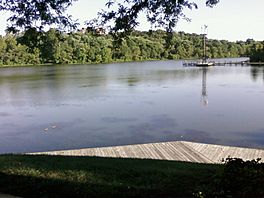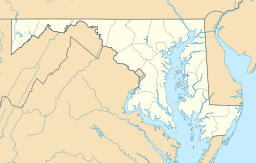Lake Kittamaqundi facts for kids
Quick facts for kids Lake Kittamaqundi |
|
|---|---|

Lake Kittamaqundi
|
|
| Location | Town Center, Columbia, Maryland |
| Coordinates | 39°12′43″N 76°51′19″W / 39.21194°N 76.85528°W |
| Type | manmade |
| Primary inflows | Unnamed tributary of the Little Patuxent River |
| Basin countries | United States |
| Surface area | 27 acres (11 ha) |
| Max. depth | 7 ft (2.1 m) |
| Surface elevation | 299 feet (91 m) |
| Islands | Nomanisan (1966-2011) |
Lake Kittamaqundi is a beautiful man-made lake covering about 27 acres. You can find it in Columbia, Maryland, right near the Mall in Columbia and Merriweather Post Pavilion. It's also easy to spot from US-29.
This lake was created in 1966 by The Rouse Company when they were building the new town of Columbia. The company said the lake was named after an old Indian settlement in Howard County. They also said "Kittamaqundi" meant "meeting place" in the tribe's language.
However, the name "Kittamaqundi" actually came from a 17th-century Piscataway village about 40 miles south. This village was named after its leader, 'Kittamaquund'. The word "Kittamaqundi" really means "Great Beaver Place" or "Strong Bear."
The area around Lake Kittamaqundi is a popular spot for fun summer festivals. It's also a fantastic place to watch 4th of July fireworks light up the sky!
Contents
How Lake Kittamaqundi Was Created
Lake Kittamaqundi is one of four man-made lakes built when Columbia was developed. These lakes were designed for two main reasons. First, they offered a lovely place for people to relax and have fun. Second, they helped collect water runoff from Wilde Lake before it flowed into the Little Patuxent River. This helped manage water levels and prevent flooding.
In 1973, experts looked into using storm water from Columbia's lakes as drinking water for homes. This idea aimed to save money on building costs.
The Bell Tower and Pathways
In 1977, a wooden flagpole that had been there for 10 years was turned into a bell tower. This tower would ring every 15 minutes, controlled from the Rouse company's main office. Sadly, the tower had to be taken down in 2010 because the wood had rotted. The Columbia Association later planned to rebuild it for Columbia's 50th anniversary.
People wanted a pathway around the lake for a long time. Funding was first looked for in 1990, but the path wasn't finished until 2014. Now, it's a great place for walks and runs!
Wildlife and Community Efforts
In 1990, some migrant geese were moved away from the lake. They were replaced with beautiful Trumpeter swans, which added to the lake's charm.
Sometimes, large groups of people gathered at the lakefront at night. To keep the area safe and welcoming for everyone, police patrols were increased around the lake and nearby neighborhoods in 1996.
By 1997, Canada goose droppings were causing a lot of cleaning work for the Columbia Association. To help with this, they hired a special Border Collie dog and its handler. Their job was to gently chase the migrant geese away from the lake.
Nomanisan Island's Transformation
Lake Kittamaqundi used to have an island called Nomanisan Island. A Columbia resident named Alan Levine gave it this name in a contest in 1980. The name came from the famous saying "No Man Is an Island" by John Donne.
During a big cleaning project in 2010, the space between the island and the east side of the lake was filled in. This turned the island into a peninsula, which is a piece of land almost surrounded by water but connected to the mainland.
The Rouse Statues
A statue of Jim and Willard Rouse, who helped create Columbia, was made. It was first placed in front of an office building. After some time, it was moved to storage. In 2000, the Columbia Association bought the statues and placed them along the lakefront in 2001 for everyone to see.
Keeping Lake Kittamaqundi Healthy
The area around The Mall in Columbia and other nearby buildings was built without much planning for stormwater. This means that rainwater runoff from these areas flows directly into Lake Kittamaqundi.
In 2008, a study showed that a lot of tiny particles and phosphorus were collecting in the lake each year. To help fix this, experts suggested building special projects to hold stormwater. These projects would help keep the lake cleaner and healthier.
Deepening the Lake
Over the years, dirt and other materials built up at the bottom of Lake Kittamaqundi. This made the lake shallower. So, in the fall of 2010, a big project called dredging began. Dredging means removing mud and sediment from the bottom of a lake or river.
This project aimed to make the lake as deep as it was when it was first created. It also helped make the lake banks stronger and created two new peninsulas. These changes help the water flow better and keep the lake clean. The dredging was finished in November 2011.
Protecting the Lake from Spills
In April 2014, there was a small accident where some diesel fuel leaked from a tank at a nearby building. The fuel went into the stormwater drains and flowed into Lake Kittamaqundi. Luckily, the Howard County Fire and Rescue team quickly cleaned up the spill to protect the lake's environment.
Amazing Fish in the Lake
Lake Kittamaqundi is home to many different kinds of fish! Here are some of the species you might find swimming there:
- Bluegill
- Pumpkinseed
- Redear sunfish
- Green sunfish
- Black crappie
- White crappie
- Common carp
- Largemouth bass







